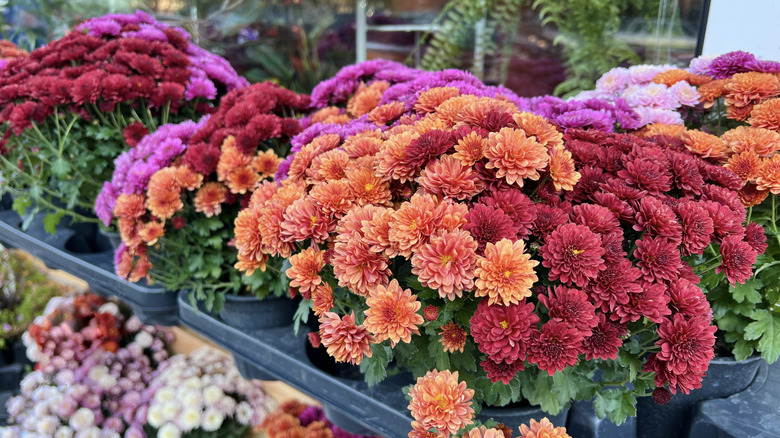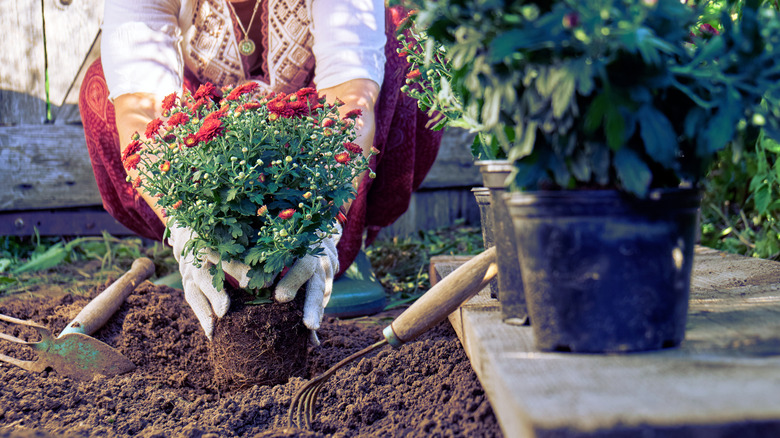How To Plant Your Potted Chrysanthemums So They Come Back Every Year
Every fall, stores and greenhouses are bursting with fresh color from chrysanthemums. Often, they are treated as annuals, but there is more life in these flowers than many people realize. If you want to get the most out of your fall mums, it's crucial to know which kind of chrysanthemum you have.
There are two main types: Florist mums and garden (or hardy) mums. Florist mums are grown inside greenhouses without being conditioned for the outdoors. Because of this, they are often weaker in the face of cold temperatures, so they are treated as annuals. Florist mums naturally bloom late in fall, and freezing temperatures of winter destroy the flower buds before they can fully develop. By contrast, hardy or garden mums are bred to better withstand colder temperatures and are hardy to USDA Hardiness Zone 5 with winter protection. Their roots can survive freezing conditions if planted properly and given time to establish before winter. Look for labels that specifically say "hardy" or "garden" mum when buying potted plants that you want to transplant.
How to plant hardy mums to survive the winter
For the best chance of your hardy mums coming back year after year, timing is crucial. Transplanted mums do best if they are planted in early spring, but at minimum they need at least six weeks to grow before freezing weather arrives. Start with good site preparation. Choose a location that receives at least 6 hours of sun and has well-drained soil. Mums don't tolerate soggy conditions, which can cause root rot over winter. If your soil is heavy clay, consider amending it with compost or planting in raised beds. Dig a hole twice as wide as the root ball but no deeper than the rootball. Place the mum so the crown is level with the surrounding soil, before backfilling and gently pressing the soil. Water thoroughly after planting and continue to water regularly, especially during dry spells.
Pinching back stems in early summer encourages bushier growth and more blooms. Remove about an inch or so from the tips once or twice before July. This not only creates a fuller plant but can delay bloom slightly, so you get vibrant color later in fall. Before winter, wait until the plant has experienced a hard frost before cutting back. Many gardeners prefer leaving stems until spring because they can help insulate the crown. Apply a thick layer of mulch (around 4 to 6 inches) after the ground freezes to protect roots from harsh temperature swings. Once established, there are many annuals that you could plant near your now perennial mums for late summer and early fall color.
Planting and dividing chrysanthemums
As mentioned earlier, be sure to plant your chrysanthemums with plenty of time to root. Hardy mums produce underground stems called stolons — the stems run horizontally and grow both roots and new shoots at various nodes. This is what makes them come back each year, as it's a form of asexual reproduction. Florist mums produce few or no stolons, so they are less likely to come back after a growth cycle. Use florist mums to create autumn displays of bright colors and hardy mums to bring color to your gardens year after year. But after a couple of years, your mums will need to be divided.
You can divide established mums by digging up the plant and washing the roots to expose the smaller plants with their own set of roots growing around the original — these are from the aforementioned stolons. Gently remove these new plants and discard the old plants. Then place your new mums in prepared beds for another two growing seasons.
You can also take cuttings from your mums. In the spring, take cuttings from your plants. Place each cutting in a rockwool or oasis cube and place it into clean sand or perlite, wetting the rooting material thoroughly. Keep the cuttings around 65 degrees and protect them from strong sunlight for a couple of days to allow them a chance to root. Chrysanthemums make good companion plants in the garden, providing late-season color when other plants have stopped blooming. With a little care, you can have endless blooms.


